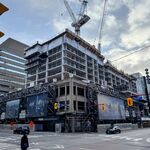bono47
New Member
The software issue has been fixed?If the report is based on today's Mx board meeting, then Verster said the signal flaw has already been fixed via software update.
The software issue has been fixed?If the report is based on today's Mx board meeting, then Verster said the signal flaw has already been fixed via software update.
Would be hilarious if TTC continued to operate buses along Eglinton once the LRT is fully in service and running, just like they run busses above subway routes.
What would be hilarious about it?
That is exactly what they are going to do, and this has been known for years.
I don't know if it has been fully repaired, but the third pair of training classes have started going out and doing their runs on the line, so it seems to me that it has been fixed enough to be safe again.If the report is based on today's Mx board meeting, then Verster said the signal flaw has already been fixed via software update.
It basically means running simulated service without passengers. For example when the TTC was testing the Toronto Rocket subway trains they would run them and open the doors on the wrong side of the train a the stations or before the extension to Vaughn opened the ran trains empty from Sheppard West station to Vaughn before they returned to pick up passengers again at Sheppard West
I don't know if it has been fully repaired, but the third pair of training classes have started going out and doing their runs on the line, so it seems to me that it has been fixed enough to be safe again.
I think the block signaling of Line 2 was a bit less complex than the hardware and software for Line 5's system, so it strikes me as apples to oranges.To give this a historical comparison, the UCRS Newsletter of February 1966 reported that the final H1 cars for the Line 2 Bloor Danforth Subway, 5496-5499, were delivered to Greenwood Yard on Jan 3, 1966. Operator training began Jan 10/66.
The system opened successfully on Feb 26, 1966.
- Paul
yea but with the amount of advances in technology to test and not to mention already in version 8 of their software you'd expect them to be able to get it right far earlier... theyve had 5 additional years to test this!I think the block signaling of Line 2 was a bit less complex than the hardware and software for Line 5's system, so it strikes me as apples to oranges.
I think the block signaling of Line 2 was a bit less complex than the hardware and software for Line 5's system, so it strikes me as apples to oranges.
It's not just signalling in the underground section, it's also automated operation. So that increases the degree of difficulty substantially.Can someone explain this to me like I'm a 5 year old - why do we need to come up with new software for what should be a pretty basic LRT system? Are there not other LRT systems that we could leverage the software from?
Is there anything really special with how Line 1 or Line 2 that made the training time so much less?
It seems like we're trying to reinvent the wheel on something that didn't need it.
The line runs automated in its grade-separated right-of-way underground/elevated (Automatic Train Operation or ATO), and once it emerges at Laird, it switches to manual control since it runs on street (Automatic Train Protection or ATP). Transitioning between the two systems on one line mid-service I believe is somewhat unconventional and is probably behind some of the headaches.Can someone explain this to me like I'm a 5 year old - why do we need to come up with new software for what should be a pretty basic LRT system? Are there not other LRT systems that we could leverage the software from?
Is there anything really special with how Line 1 or Line 2 that made the training time so much less?
It seems like we're trying to reinvent the wheel on something that didn't need it.
It's not just signalling in the underground section, it's also automated operation. So that increases the degree of difficulty substantially.
Exactly!Agree, but the same question..... did ML buy a proven product or was this custom designed during the project execution?
- Paul




